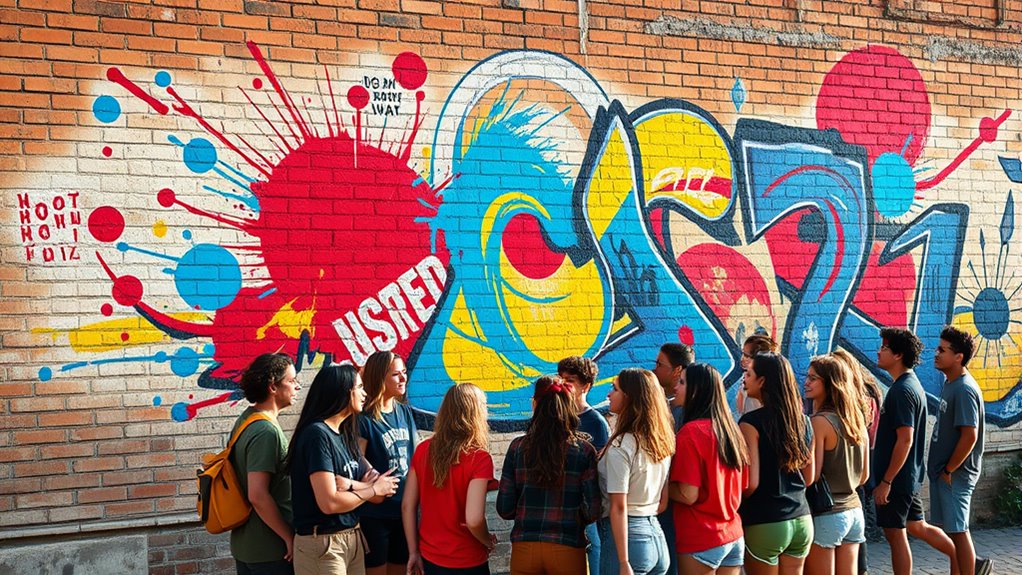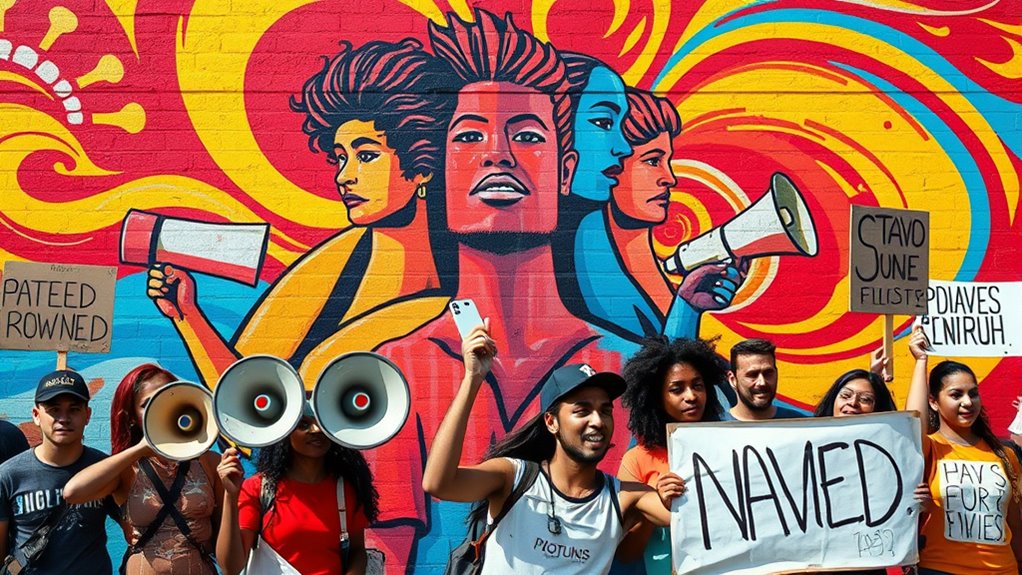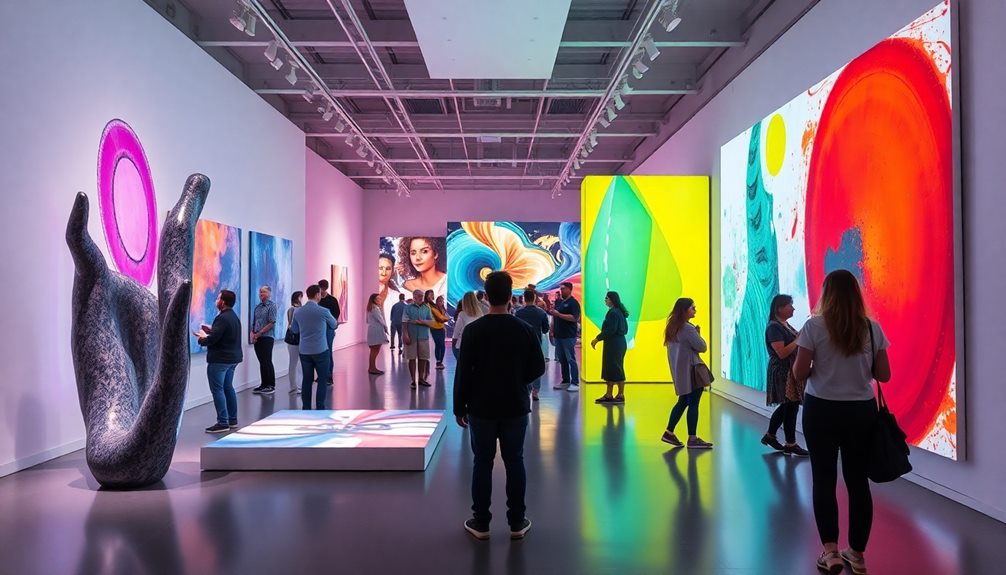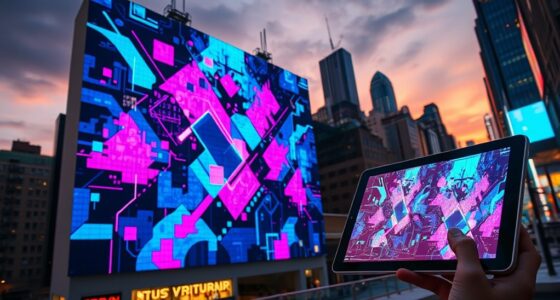Art and activism combine to create powerful tools for social change by transforming public spaces through murals and performances that challenge injustice and inspire dialogue. Murals communicate messages visually, turning walls into platforms of resistance, while performance protests engage audiences emotionally and actively. These creative expressions foster community pride, deepen understanding, and motivate action. Exploring these dynamic methods reveals how art can amplify your voice and ignite meaningful social impact—there’s much more to discover in this vibrant intersection.
Key Takeaways
- Art and activism use murals and performances to visually communicate social issues, inspiring reflection and mobilization.
- Creative expressions transform public spaces into platforms for political statements and community engagement.
- Visual storytelling techniques in art deepen emotional impact and make complex issues accessible.
- Performance protests combine art forms like dance or music to create immersive experiences that challenge passivity.
- Community involvement in artistic activism fosters ownership, sustainability, and broader social impact.

Have you ever wondered how art can spark social change? It’s a powerful tool that transforms public spaces and personal expressions into platforms for activism. When you walk through a city, you might notice vibrant street murals that do more than just beautify walls—they tell stories, challenge perceptions, and demand attention for issues often overlooked. These murals serve as visual protests, capturing moments of resistance or hope, and making political statements accessible to everyone. They turn blank walls into canvases of dissent, inspiring viewers to reflect and act. Street murals are more than artwork; they’re acts of rebellion that can unite communities and highlight social injustices, giving voice to those who are often silenced. Vetted murals, often created with community involvement, can foster a sense of ownership and pride among residents, further amplifying their impact. Additionally, the use of high contrast ratios in these visual displays can enhance the clarity and emotional impact of the messages, making them even more striking. Incorporating visual storytelling techniques can deepen the narrative and emotional resonance of the murals, engaging viewers on a more profound level.
Alongside murals, performance protests have become a dynamic form of activism that engages the public in a visceral way. Picture a street scene where activists take to the pavement, using dance, music, or theatrical acts to communicate their message. These protests are not just about shouting slogans—they’re about creating an experience that draws in onlookers, making the issues personal and immediate. Performance protests often blend art and activism seamlessly, turning a simple demonstration into a compelling spectacle that demands attention. For example, a choreographed dance on a busy street might symbolize oppression or resilience, leaving a lasting impression on those who witness it. These performances challenge the passivity of spectators, inviting them to become part of the dialogue rather than just observers.
Both street murals and performance protests harness the power of creative expression to challenge injustice and push social causes into the spotlight. They break down barriers of language and cultural differences, making complex issues accessible through visual and performative artistry. When you see a mural, you’re not just looking at paint—you’re engaging with a message that’s been carefully crafted to provoke thought and inspire action. When witnessing a performance protest, you’re experiencing activism firsthand, feeling the energy and emotion behind it. These art forms make activism tangible, memorable, and impactful, often sparking conversations that ripple beyond the moment. Furthermore, incorporating community involvement in these projects can significantly enhance their effectiveness and sustainability, fostering ongoing dialogue and support.
Frequently Asked Questions
How Do Artists Measure the Impact of Their Activism?
When you want to measure your activism’s impact, focus on audience engagement and impact assessment. Track how your work resonates with people—are they sharing, discussing, or acting upon your message? Use surveys, social media analytics, and community feedback to evaluate change. This helps you understand if your art sparks awareness or action, guiding you to refine your approach and maximize social influence effectively.
What Are Some Examples of Successful Art-Driven Social Movements?
You see that successful art-driven social movements use public murals and performance protests to inspire change. For example, powerful murals raise awareness about social issues, while performance protests engage audiences emotionally and physically. These art forms create a visual and experiential impact that captures attention, sparks conversations, and mobilizes communities, proving that creative expression can be a powerful tool for social change.
How Can Emerging Artists Get Involved in Activism?
To get involved in activism, you should focus on community engagement and artistic collaboration. Attend local events, join organizations, and connect with like-minded artists dedicated to social issues. Use your skills to create impactful artwork that raises awareness and sparks dialogue. Collaborate with community members to guarantee your efforts resonate and make a real difference. Your active participation can inspire others and drive meaningful social change through art.
What Ethical Considerations Arise in Politically Charged Art?
When creating politically charged art, you face ethical considerations like art censorship and your moral responsibility. You must balance expressing your views while respecting diverse perspectives, avoiding harm or misrepresentation. Be mindful of potential censorship that could limit your message, and consider how your work impacts viewers emotionally and socially. Staying true to your values while maintaining respect ensures your art fosters dialogue without crossing ethical boundaries.
How Do Cultural Differences Influence Art as Activism?
You might be surprised to learn that over 70% of global audiences interpret artistic symbolism differently across cultures. Cultural differences profoundly shape how art as activism is perceived; cross-cultural perspectives influence the messages conveyed and understood. You should consider that diverse backgrounds bring unique interpretations, making it essential to adapt your artistic symbolism thoughtfully. This ensures your activism resonates universally, fostering understanding and dialogue across cultural boundaries.
Conclusion
By embracing art as your voice, you become a powerful catalyst for change. Your creative expressions can ignite passions, challenge injustices, and inspire action—proving that art isn’t just for beauty but for revolution. Remember, your voice holds the magic to transform society. So don’t hold back; let your art speak louder than words, for in your hands, creativity becomes the spark that lights the fire of social change.









